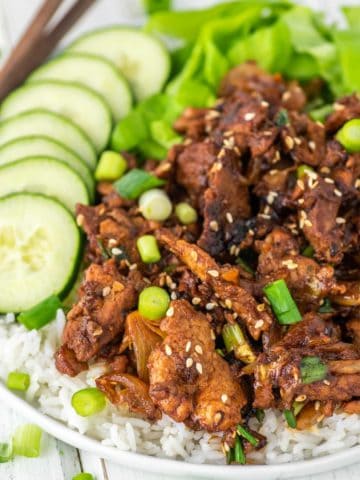This gochujang fried rice takes less time than it takes to drive to a restaurant and pick it up and is kicked up a notch by the spicy/sweet Korean paste. I mean there isn't much better than a meal that's ready in under 20 minutes.

When it comes to weeknight meals, you can never go wrong with something that can be prepared in under 30 minutes - from salt and pepper chicken to teriyaki shrimp to Mongolian pork to chicken Manchurian.
As you can tell, Asian-inspired recipes are usually pretty quick to prepare and also loaded with flavor.
And this gochujang fried rice combines two food cultures, Chinese and Korean. If you weren't aware, fried rice originated in China, while gochujang is a Korean paste that is thick and spicy. It is made from red chile pepper flakes, rice, fermented soybeans and salt.
The end result is the wonderful flavors and textures of fried rice which has an added spice level and color from the gochujang. I'll be honest when I say it is pretty addicting.
Jump to:

Ingredient Notes
- Pork tenderloin - I'm a fan of pork here as it can be cut into cubes and cooked quickly. You can also just omit the protein.
- Veggies - typical fried rice includes peas, carrots, green onions, garlic and ginger. You get texture and flavor from them.
- Long-grain rice - leftover rice from the day before works best. You can use either white or brown rice.
- Gochujang - this Korean chili paste is the star of the show and the main flavor of the rice. It is a savory, sweet, and spicy fermented condiment that is very popular in Korean cuisine.
Ingredient Swaps
Like any recipe, you can mix up some of the ingredients if you'd like. Some variations include:
- While I use vegetable oil for the veggies, you can use butter as well or replace with something like canola or avocado oil.
- If you don't have or like pork, chicken, beef, shrimp or tofu can be substituted.
- Peas and carrots are go-to veggies in a fried rice recipe, but you can use your favorites - from broccoli to sugar snap peas to mushrooms.
- Soy sauce is where a lot of the flavor/salt comes from, but if you are gluten-free try tamari sauce.
- I'm partial to cashews with this recipe, but peanuts work great too.
Step-by-Step Photos

Heat the oils over medium-high heat in a skillet before adding the seasoned pork, cooking for 4-5 minutes or until done. Remove the pork and add the carrots, peas and onions, cooking for 2 minutes. Add the garlic and ginger, cooking for another minute.

Push the veggies to the side and add the eggs, cooking to scramble. Add the pork back in with the rice, gochujang and soy sauce, stirring to combine. Taste and adjust for seasoning.
FAQs
If you start with sticky, warm, just-cooked rice, your fried rice will turn out soggy. You won't get that distinct chewy grain you expect from fried rice.
So if you have time, cook the rice at least a day ahead of time and refrigerate. This helps to dry the grains out enough to give your fried rice a good texture. If you don't have time for this, then use two pouches of ready-to-serve rice.
Usually dried rice multiplies by 3 when cooked, so you'll want 1 ⅓ cups dried rice to get 4 cups cooked rice.
Yes. I actually have a tasty cauliflower fried rice recipe.
Yes. I use it because it is easy to get 1 lb. But pork shoulder or pork belly works great as well. Or as I mentioned above just use a different protein entirely.
Everyone has a level of spice they can handle. Gochujang does have some heat, so if you like more heat add 1 tablespoon at a time. If you can't handle too much heat, just use 1 tablespoon less at a time until it reaches your spice level you enjoy.
I found ¼ cup to be just the right amount.
Like beef, pork has different temperatures, depending on your tastes. The minimum is 145°F, but it can go as high as 165°F. This pork is cut small, so it will be cooked very quickly but will remain tender.
You can place the gochujang fried rice in an airtight container in the fridge for 2-3 days or in the freezer for 3 months.
Pro Tips/Recipe Notes
- Take the time to cook the rice the day before as it gives that texture you expect from fried rice.
- Be consistent with the size you dice the pork so it cooks evenly.
- Cook the pork in batches so you don’t overload the skillet or wok and cool it down. You want to cook the pork quickly and adding too much at a time will slow the cooking process.
- Leftover fried rice can be stored in an airtight container in the fridge for 3 days.

Similar Recipes
If you’ve tried this gochujang fried rice recipe or any other recipe on Chisel & Fork, please let me know how it turned out in the comments below! You can also follow me on Facebook, Instagram, Pinterest and YouTube to see more tasty meals and anything else I'm up to.
Gochujang Fried Rice
Ingredients
- 2 tablespoon vegetable or canola oil
- 2 tablespoon sesame oil
- 1 lb pork tenderloin, cut into ½ inch pieces
- 1 ½ cups frozen peas and carrots
- 4 green onions, chopped
- 4 garlic cloves, minced
- 2 teaspoon fresh ginger, finely chopped
- 3 eggs, lightly beaten
- 4 cups cooked long-grain rice
- ¼ cup gochujang
- 2 tablespoon low-sodium soy sauce
- ¼ cup chopped cashews or peanuts (optional)
Instructions
- In a large wok or skillet, heat the vegetable and sesame oil over medium-high heat. Lightly season the pork with salt and pepper and cook in skillet for 4-5 minutes, or until cooked through. Transfer pork to a plate and set aside.
- Return wok to medium-high heat and add the peas, carrots and green onions, cooking for about 2 minutes or until vegetables have softened. Add the garlic and ginger and cook for another minute.
- Push the vegetables to one side of the wok and add the eggs, cooking to scramble.
- Return pork to skillet with the rice. Add gochujang and soy sauce and stir to combine. Cook for about 2 minutes or until pork is warmed through. Taste and adjust for seasoning.
Notes
- Take the time to cook the rice the day before as it gives that texture you expect from fried rice.
- Be consistent with the size you dice the pork so it cooks evenly.
- Cook the pork in batches so you don’t overload the skillet or wok and cool it down. You want to cook the pork quickly and adding too much at a time will slow the cooking process.
- Leftover fried rice can be stored in an airtight container in the fridge for 3 days.














Leave a Reply